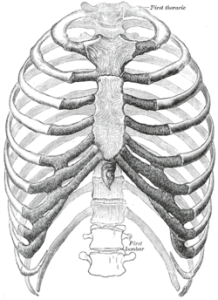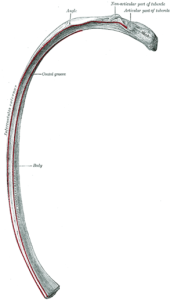 Do you suffer from mysterious chest pains that occur for no apparent reason? Does it hurt to cough? Do other actions, like twisting or bending, cause a similar enigmatic pain? If the answer is yes you might have a dysfunctional rib.
Do you suffer from mysterious chest pains that occur for no apparent reason? Does it hurt to cough? Do other actions, like twisting or bending, cause a similar enigmatic pain? If the answer is yes you might have a dysfunctional rib.
In general the human rib cage has twenty-four ribs (two sets of twelve) with different types of attachments. Seven of the ribs—the first seven in descending order—attach at the back to the thoracic, or middle, section of the spine. These same seven ribs also wrap around to attach to the sternum, or breast bone.
The eighth, ninth and tenth ribs attach directly to the thoracic spine at the back but only connect to the sternum via the cartilage of the ribs above. The final two pair of ribs are referred to as floating ribs because they only attach to the thoracic spine and not to the sternum. If you dig around in your side body you should be able to locate and palpate your floating ribs.
The main function of the rib cage is to form a hard shell of protection around the heart and lungs. As solid as this cage is it is also quite mobile in order to facilitate breathing.
With each and every breath that we take the ribs move in a coordinated fashion of allow for the increase and decrease in the volume of the lungs. And it is likely that you will probably take around 20,000 breaths in an average day, so that is a lot of daily movement.
Ideal breathing allows the ribcage to move in three planes when we inhale and exhale—up and down, back and forward and side to side (The fact that most people are getting movement in only one or two of these planes is significant but not the purpose of this post).
So the answer to the question at the top is… a dysfunction rib is one that doesn’t move in coordination with the rest of its brethren. For whatever reason, and I will list some below, one of the joints of your ribs, fails to move when all the rest do and this can lead to acute pain which untreated can easily become chronic.
The correct follow-up question is of course, how does someone get a dysfunction rib?
The most obvious means to a dysfunctional rib is blunt force trauma from some kind of accident. But there could be numerous other contributing factors. Poor posture and skeletal alignment in general (And skeletal problems like scoliosis in particular) can add to strain that might lead to a rib moving out of its proper position.
Also, it is easier than you might think to throw one of your joints out of whack by sneezing and/or coughing. And that could be an issue of muscle tone. Muscle development, or lack thereof, can be a factor. While muscles don’t connect bones to each other (that is the job of ligaments) their relative tone effects how the bones and joints relate to each other.
Healing a dysfunction rib can be easy or complicated depending on the origin and duration of the injury. Sometimes a single manual adjustment is all that is needed to reset the joint. If inflammation is an issue it might need to recede before that manual adjustment is possible.
But sometimes, due to the extremity of the injury or the reasons for the dysfunction, it can be very difficult to find your way quickly out of pain.
From my perspective (since it is what I teach), learning to walk and stand in a new way, combined with release exercises can be a long term (albeit taking a long time) solution.
***
